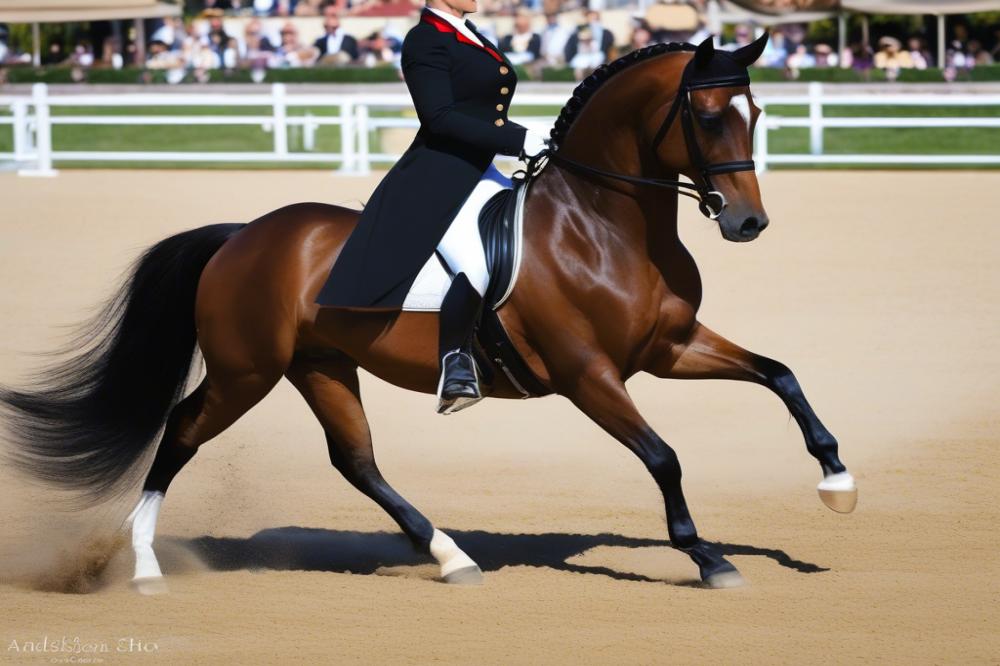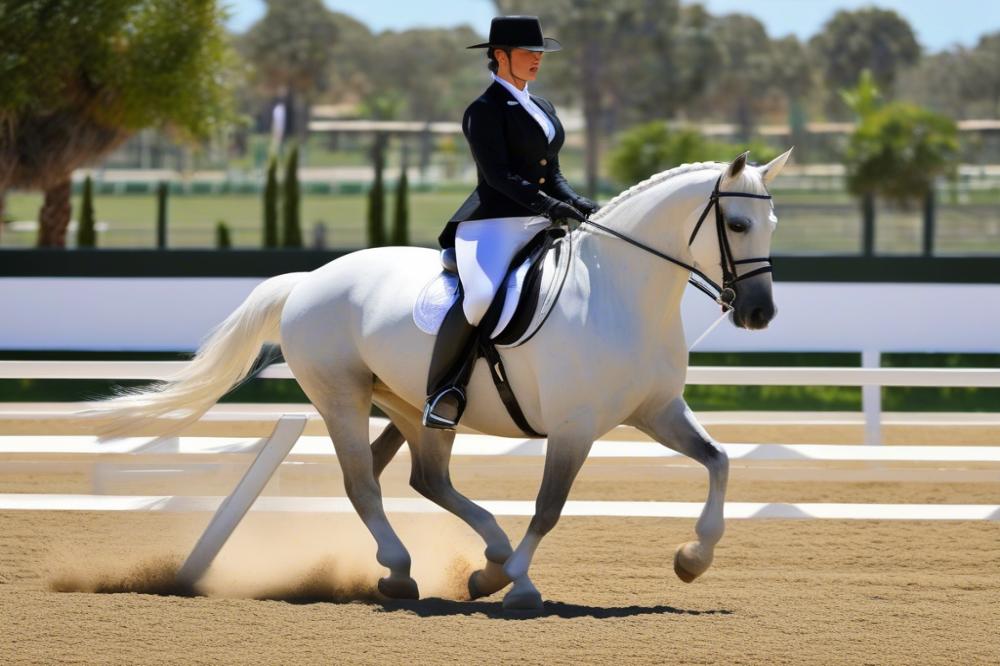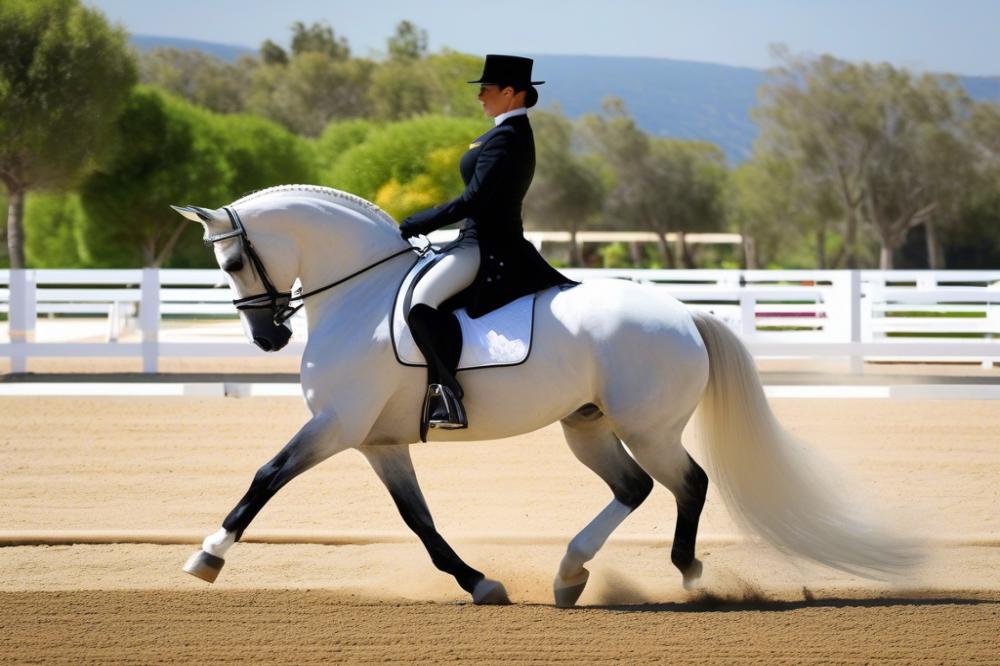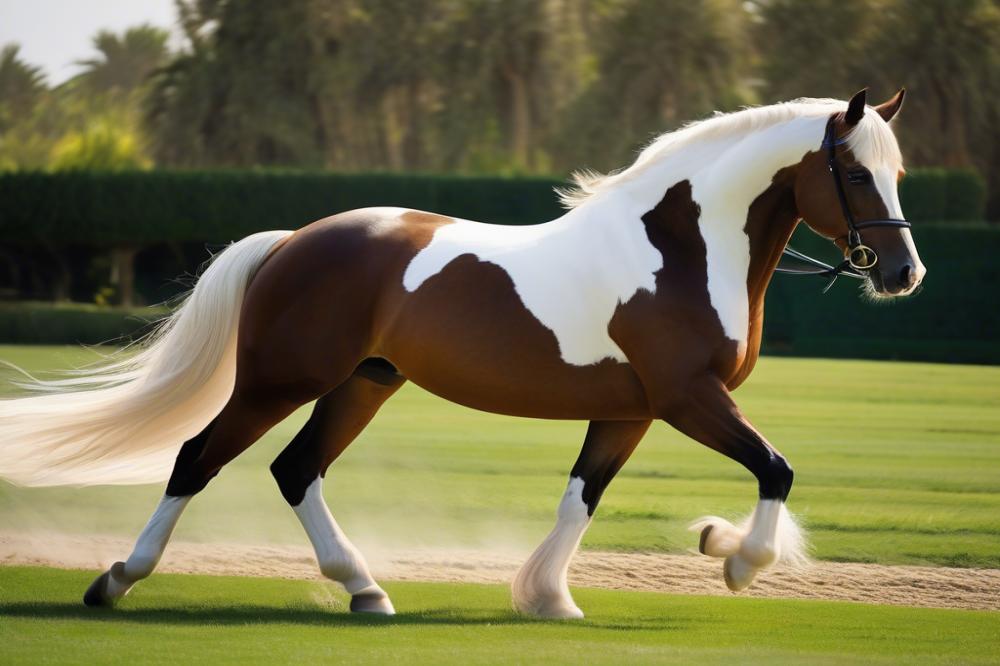Understanding the Andalusian horse
The Andalusian horse, known for its grace and agility, has a rich history that makes it an exceptional candidate for advanced dressage movements. These horses have a strong connection to traditional equestrian arts. Their natural elegance and balanced disposition allow them to excel in complex maneuvers, captivating both spectators and riders alike.
Proper preparation of any horse is critical, especially when training for high-level dressage. A horse must develop both physical strength and mental focus to successfully tackle advanced techniques. Training should involve systematic methods that promote physical fitness and enhance responsiveness. This foundation establishes trust between horse and rider, a necessary element for nuanced performance.
Advanced dressage training aims to refine the horse’s movements through precision and fluidity. It focuses on developing skills such as collection, alongside lateral movements that require both strength and flexibility. The end goal is a harmonious partnership where rider and horse work seamlessly together. Such an achievement is not only rewarding but also showcases the beauty and athleticism of equestrian sports.
Understanding the Andalusian Breed

Historical Background of the Andalusian Horse
The Andalusian horse has a rich history that dates back centuries. Originating in the Iberian Peninsula, these animals were bred for both battle and agriculture. Their lineage can be traced to the ancient horses brought by Phoenicians and Romans. In the Middle Ages, the breed was highly regarded for its strength and stamina. By the Renaissance, Andalusians became favorites among nobility and were celebrated in art and literature. This long-standing heritage contributes to their noble presence and versatility today.
Characteristics That Make the Andalusian Horse Ideal for Dressage
Several traits of this breed stand out when considering dressage. Their natural elegance is immediately impressive. A well-muscled body, paired with a strong back, supports advanced movements. Furthermore, the horses exhibit a high degree of intelligence, which aids in quick learning. They often have a calm demeanor, helping them remain focused during training sessions. The distinctive flowing mane and tail also add to their aesthetic appeal in competitions. All these features combine to create an ideal partner for advanced equestrian disciplines.
Natural Abilities and Disposition Related to Advanced Equestrian Skills
Innate qualities play a crucial role in an Andalusian’s aptitude for dressage. First, their agility allows for complex maneuvers. Many riders appreciate their ability to perform grand movements with grace. High levels of sensitivity also contribute, as these horses can easily respond to subtle cues from their riders. Some may describe them as eager performers, often displaying a strong willingness to please. This combination of physical capabilities and temperament makes them especially suited for advanced techniques in dressage.
Foundational Training for Advanced Dressage

Establishing a solid groundwork is crucial when preparing for advanced dressage movements. Without this foundation, a horse may struggle to respond to the more complex tasks that advanced training demands. A horse needs to understand basics like balance, rhythm, and relaxation before moving on to intricate movements.
Basic dressage training techniques serve as building blocks for progression. Start with initiating proper bending. Circle work helps the horse develop suppleness and flexibility. Transitions are also important. They can teach the horse how to remain responsive to the rider’s aids, setting the stage for more challenging maneuvers later.
Work on straightness as well, as this contributes significantly to the horse’s overall performance. Simple exercises like shoulder-in and haunches-in help achieve this. Learning to yield to pressure from the rider’s legs is another fundamental skill. A horse that understands these basics can then ascend to advanced movements with greater ease.
Effective communication between horse and rider is key. Developing this partnership takes patience and kindness. Always reward your horse for their effort, no matter how small. Body language plays a huge role; subtle shifts in your weight or leg position can guide them more than you might think. Consistent cues build a deeper understanding over time.
Riders should also be aware of their own body mechanics. Being relaxed and balanced in the saddle allows for clearer signals. Your posture impacts the horse’s response. Trust grows as you both learn each other’s strengths and weaknesses.
Movement Collection Techniques

Movement collection refers to the ability of a horse to engage its hindquarters while lightening its forehand. This skill is vital in advanced dressage because it allows for higher levels of precision in movements. A well-collected horse exhibits balance and responsiveness while performing complex maneuvers. Without collection, techniques can appear disjointed or difficult, even for seasoned riders.
Exercises and Practices to Enhance Collection
One effective method to improve collection is the use of transitions. Frequent changes between gaits can encourage the horse to shift weight correctly. For example, moving from trot to walk and back again activates the horse’s hindquarters. This engages muscles that aid in collection, fostering strength and balance.
Cavaletti work also plays a significant role. Setting up poles at varying heights and distances sharpens the horse’s awareness of its legs. Practicing this can lead to improved coordination and help the horse stay lifted in its movement. It’s important to change the exercises regularly to challenge the horse and avoid monotony.
Tips for Maintaining Balance and Posture During Collection
When working on collection, maintaining proper balance is crucial. The rider’s posture greatly affects the horse’s performance. Keeping a deep seat and relaxed shoulders allows for better communication with the horse. This alignment promotes natural movement, fostering more effective collection.
Additionally, using your legs properly is essential. Apply gentle pressure with your calves to encourage engagement. Riding in smaller circles or leg yields can help the horse focus on its balance, allowing it to collect more efficiently. Remember, even a slight change can make a significant difference.
Lateral Work and Its Importance
Lateral work is a fundamental aspect of dressage training. Performing these movements helps improve balance and coordination in the horse. Moreover, it enhances communication between horse and rider. Understanding lateral work lays the groundwork for more advanced techniques. Each action influences the horse’s agility and body awareness.
Key Lateral Movements to Master
A few key movements are essential for mastering lateral work. Leg yields are one of them. This movement involves the horse moving sideways while going forward. Another important maneuver is the shoulder-in. In this movement, the horse’s shoulders move inward while maintaining a straight line. This action improves suppleness and openness in the horse’s frame.
Techniques to Improve Lateral Flexibility and Responsiveness
Fostering flexibility requires careful training. Start with ground exercises to help the horse feel comfortable. Use cones or poles to encourage lateral movement at a slow pace. Gradual progression is crucial; don’t rush through each step. Incorporating circles into exercises can also improve responsiveness. These shapes encourage bending and engaging different muscles.
Riders must focus on their own position as well. If the rider maintains a balanced seat, the horse will respond better to commands. Subtle cues from the rider’s leg and seat can greatly enhance performance. It’s essential to practice patience; every horse develops at its own speed.
Adding variety to training sessions makes them more enjoyable. Introduce new exercises regularly to keep the horse engaged. Consistency is key, but so is creativity in the practice routine. Ultimately, mastering lateral work will significantly benefit the horse’s dressage skill set.
Piaffe Training and Advanced Transitions
Understanding the piaffe and its role in advanced movements
The piaffe is a crucial component in advanced dressage. This collected trot requires the horse to remain balanced while lifting its legs in a rhythmic motion. Mastering this movement can set the stage for a variety of complex maneuvers. Judges look for smoothness and precision in the piaffe. It is more than just a show of strength; it’s an expression of harmony between horse and rider. Ability to perform this movement well reflects a horse’s training level and responsiveness.
Step-by-step approach to training the piaffe with the Andalusian horse
Begin by establishing a solid foundation with basic movements. Working on transitions between walk and trot helps build the necessary strength. Use half-halts to engage the horse’s hindquarters. Gradually introduce the concept of the piaffe by asking for a slow trot in place. Short sessions keep the horse engaged and focused. Reward the horse for any attempt or inclination to elevate its legs. Slowly increase the duration of each training session. The use of poles can help refine footwork and coordination. Consistency is key, so practice regularly while maintaining patience.
The significance of transitions and how to incorporate them into training
Transitions teach the horse how to respond to your cues. They also enhance overall balance and athleticism. Start with simple transitions between walk and trot, then add canter as the horse progresses. Focus on smooth changes to build confidence. These exercises prepare the horse for more intricate movements later on. Incorporate transitions within the piaffe to help the horse understand shifting gears while maintaining rhythm. As it improves, work on transitions between lateral movements, such as shoulder-in and haunches-in. This can create a seamless flow that visually captivates audiences. Training should always prioritize mental challenges as well as physical ones.
Developing a Training Plan for Advanced Movements
Creating a training schedule for advanced dressage requires careful planning. Consider the horse’s current abilities and progress. Each session should focus on specific goals. This approach helps to track advancement over time.
Incorporating various exercises is essential. Lateral work, for example, builds flexibility and balance. Movements like leg yields and shoulder-in ask the horse to engage its muscles differently. Regular practice of these exercises strengthens the horse’s coordination.
Piaffe is another important element. This movement requires the horse to trot in place while maintaining rhythm. It challenges both horse and rider and demands precision. Start with short sessions to avoid fatigue.
Adjusting training intensity is crucial. Pay attention to the horse’s signals, as every animal progresses at its own pace. If your horse seems tired, reduce the workload. Likewise, if the horse shows eagerness, you might increase the difficulty for that day.
Rider skills also play a role. As the rider improves, the horse can be introduced to more complex movements. Frequent feedback is vital. It keeps the training dynamic and ensures lessons remain relevant. This constant adaptation will help avoid plateaus in progress.
To maximize the effectiveness of each session, consider varying the environment. Training in different locations can build confidence. New surroundings often encourage freshness to the routine. Both horse and rider can benefit from these small changes.
Finally, remember to schedule rest days. Adequate recovery time allows for mental and physical recuperation. Balance in training and rest is key for long-term success in advanced dressage.
Wrapping It Up
Recapping the essentials of how to prepare an Andalusian horse for advanced dressage movements highlights several key elements. First, a solid foundation in basic skills cannot be overlooked. Without mastering fundamental movements and commands, nothing beyond those will follow smoothly. horse preparation goes beyond just physical training; it involves developing understanding and communication between horse and rider.
Patience plays a critical role during this journey. Advanced movements require time and repetition. Rushing through training can lead to confusion and setbacks. Each session needs careful attention to detail and a commitment to slow, steady progress. Recognizing when to move forward and when to revisit basic skills is vital.
Building a true partnership with your horse will yield the most rewarding dressage experiences. Establishing trust is essential. A horse that feels secure with its rider performs better. Consistency in training aids this bond. Much of dressage training thrives on clear communication. Each cue and response should be as natural as a conversation.
Emphasizing these points will set the stage for successful, engaging work together. Enjoy the journey ahead and celebrate the little victories along the way. The dedication invested in this process will lead to remarkable results. Each step, no matter how small, contributes to the grander objective of dancing through advanced dressage movements together.



